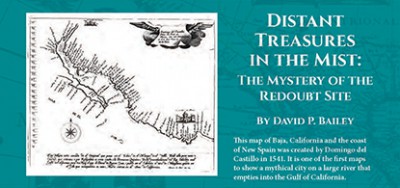WHAT WAS THE WESTERN INVESTIGATIONS TEAM?
The Western Investigations Team was composed of Museum of Western Colorado staff, scientists, consultants and college interns. The group worked as a team to solve enduring mysteries of the West through historical research and by using the latest in scientific technology. The group started as a result of the success of the Alferd Packer Lost Camp Expedition, which discovered Packer’s cannibal camp in Lake City. Museum of Western Colorado’s Curator of History David Bailey served as Director of the Western Investigations Team (WIT) and consulted with Colorado Mesa University professors and scientists.

Spanish colonial historians often emphasize the importance of Spanish exploration in opening the American West and Southwest to trade and eventual settlement. What is often overlooked, however, is an explanation of the motivation for these explorers to travel into the unknown and dangerous region north of the conquered Aztec Empire.
The Distant Treasures in the Mist exhibition at the Museum of Western Colorado’s Museum of the West tells the story of what motivated these explorations and presents the information they obtained on their journeys to the northern frontier.
IN SEARCH OF THE SEVEN CITIES OF GOLD
The New World’s first conqueror was Hernan Cortés. In a long letter written by Cortés to the Emperor Charles V of Spain, he tells of his first conversation with the Aztec ruler Montecuhzoma, on Nov. 8, 1519, on the eve of the destruction of the Aztec Empire. Read more here.
(From Entrada: Heritage of the Upper Colorado River Basin, 2014, Issue I)

For thousands of years the Kannah Creek area has been home and refuge, first to native groups, then mountain men, explorers and settlers. The appeal of this small green valley between high desert plateaus is the cold clear water that flows from Grand Mesa, situated 5,000 feet above the valley floor. It may seem the perfect place to do an archaeological investigation. However, the usually gentle Kannah Creek can become a channel for rapid snow melt and flash floods.
Over the centuries the creek banks have been stripped of soils and then covered again time after time. The archaeological record is not found in neat stratified layers but is a jumbled mess near the banks of the creek. This can be a curse or a blessing for the diligent researcher when artifacts buried for centuries are brought to the surface.
In March of 2004 I received a letter and newspaper article from Anita Clark detailing the 1961 discovery of a strange relic found on a family hike in Kannah Creek. She said the artifact had been sent off for scholarly study to historian Father Sierra in Pueblo, Colorado, and never returned to her and her husband. The article suggested the relic was a fragment of a 17th century processional cross from the Dominguez and Escalante Expedition, named for two Catholic priests who traveled through present day western Colorado in 1776. Read more here.
(From Entrada: Heritage of the Upper Colorado River Basin, 2014, Issue I)
